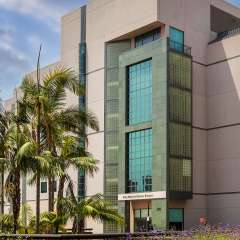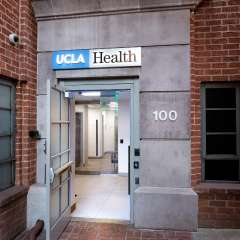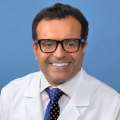Complex Pediatric Airway Reconstruction, Swallowing and Tracheostomy

Why choose the UCLA Complex Pediatric Airway Reconstruction, Swallowing and Tracheostomy Program?
Our program is one of the few in the nation dedicated to children with complex airway and swallowing disorders. Board-certified specialists in numerous fields collaborate to give your child comprehensive, next-level care. When you choose UCLA Health, you can expect:
Renowned excellence: UCLA Health's head and neck surgery program is widely known for its outstanding quality, regularly ranked among the nation's top programs by U.S. News & World Report. Numerous physicians from our program are also listed among Los Angeles Magazine's “Top Doctors” and “Super Doctors” in Southern California.
Compassionate care: We prioritize your child’s comfort and wellbeing, offering individualized support throughout their treatment journey.
Family-centered approach: You are actively involved in your child’s care, and we ensure that you are fully informed at every stage and work with you to develop a complete treatment plan.
Team of experts: Our pediatric specialists work together to deliver comprehensive care. Our team includes specialists in otolaryngology (ear, nose and throat), pulmonology (respiratory system), gastroenterology (digestive system), speech-language pathology and respiratory therapy. Additional team members specializing in pediatrics include cardiothoracic (heart and chest) surgeons, craniofacial (skull and face) surgeons, neonatologists (newborns with complex conditions), intensivists (critical care) and anesthesiologists (pain management during surgery).
Research focus: Our doctors are also active researchers who regularly publish their work about airway and swallowing care. That means your child has access to the latest treatments and innovations.
Complex pediatric airway and swallowing disorders we treat
Breathing, speaking and swallowing can be difficult when structures in a child’s respiratory system are diseased, narrowed or obstructed. These structures include:
- Pharynx (throat)
- Larynx (voice box)
- Trachea (windpipe)
Some children are born with airway and swallowing conditions (congenital). Others develop them from trauma, disease or prolonged use of a breathing tube.
Our team treats the most complex airway and swallowing conditions in children, including:
Airway stenosis
Airway stenosis is narrowing of the airway, causing hoarseness or difficulty breathing. Airway stenosis types depend on their location and include:
- Glottic stenosis: Narrowing of the larynx at the vocal cords
- Subglottic stenosis: Narrowing of the larynx below the vocal cords
- Tracheal stenosis: Narrowing of the trachea
Other airway conditions
We treat all other airway conditions, including:
- Complete tracheal rings: Cartilage rings in the trachea are usually “C”-shaped. Complete tracheal rings are “O”-shaped and smaller-than-normal, causing difficult, noisy breathing.
- Laryngeal (laryngotracheal) cleft: An abnormal opening between the larynx and esophagus allows food and liquid to enter the lungs. The opening may extend to the trachea.
- Laryngomalacia: Tissues above the vocal cords are soft and floppy, causing a partial airway obstruction. It’s the most common cause of noisy breathing (stridor) in infants.
- Stridor: Stridor is noisy breathing caused by vocal cord paralysis or an obstruction or narrowing in the airway.
- Tracheoesophageal fistula: An abnormal connection between the esophagus and trachea allows food and liquids to reach the lungs.
- Tracheostomy dependence and tracheostomy-related disorders: After making an opening in the neck, doctors insert a tracheostomy tube in the trachea to help with breathing. Prolonged use of a tracheostomy tube for ventilation can cause various complications.
Voice-related conditions
Voice disorders can stem from many causes, such as:
- Complex voice disorders: Conditions causing complex voice disorders include nodules, vocal cord paralysis, cysts, muscle tension imbalance, polyps, scarring and chronic laryngitis.
- Glottic diastasis: An abnormal gap between the vocal cords can cause voice problems.
- Recurrent respiratory papillomatosis: The human papillomavirus (HPV) causes benign wart-like growths on or near the vocal cords, resulting in hoarseness or other voice changes. Large growths may also make breathing difficult. The growths may return after they are removed because the virus remains in the tissue.
- Vocal fold paralysis: The vocal folds, also known as vocal cords, don’t move, affecting breathing and speaking.
Swallowing disorders
Common swallowing disorders in children include:
- Cricopharyngeal achalasia: The muscle at the top of the esophagus (food tube) doesn’t relax, making swallowing difficult.
- Dysphagia and aspiration: Dysphagia is the medical term we use when a child has trouble swallowing. Swallowing difficulties can cause food and liquid to enter the windpipe and lungs (aspiration).
Tests and procedures we offer
Your child’s doctor may refer you to a pediatric ear, nose and throat (ENT) doctor (otolaryngologist). Pediatric otolaryngologists have specialized training in children’s airway and swallowing conditions. They work with other pediatric specialists and you to develop an effective treatment plan for your child.
Diagnosing complex pediatric airway and swallowing disorders
Our providers use several tests to diagnose airway and swallowing problems in children, including:
Lab tests
Your child’s doctor may request samples of blood, urine or tissues to analyze in a lab. Information from lab tests can provide valuable health insights.
Imaging
Your doctor may request detailed pictures of your child’s airways, lungs and blood vessels. Common imaging tests include:
- Chest X-ray: This technique uses electromagnetic radiation to capture images of the inside of your child’s chest.
- Computed tomography (CT) scan: By combining X-rays and computers, this scan produces detailed images of your child’s respiratory system.
- Magnetic resonance imaging (MRI): Using radio waves, high-powered magnets and a computer, this test creates detailed images of your child’s airway structures.
- Esophagram (barium swallow study): Your child swallows a solution with barium, which coats the esophagus as it moves down to the stomach. Barium helps your doctor observe your child’s esophagus in action during a specialized X-ray called fluoroscopy.
- Modified barium swallow study: Similar to a barium swallow, this test checks to see if food or liquids enter your child’s lungs.
Endoscopic imaging tests
We insert a flexible or rigid tube with a light and camera at the end (endoscope) through the nose or mouth to view portions of your child’s airway. Specialized endoscopic tests we perform in our office include:
- Laryngoscopy: Views the larynx
- Flexible (fiberoptic) endoscopic evaluation of swallowing: A laryngoscopy that focuses on the swallowing process
- Bronchoscopy: Looks at the trachea
- Esophagoscopy: Evaluates the esophagus
- Endoscopic biopsy: Takes tissue samples to be analyzed in a lab
- Triple endoscopy: Evaluates the airway, lungs and upper gastrointestinal tract in a single endoscopic procedure in the hospital
Treating complex airway conditions and swallowing disorders
Most airway treatments aim to widen the airway and remove obstructions to make breathing easier. Depending on your child’s specific diagnosis and needs, their airway treatment may include oral medications, injections, surgery or a combination. We offer:
Nonsurgical treatments for complex pediatric airway conditions
Medications can help treat some airway conditions. Your child’s doctor may also recommend injecting steroids into the airway structures to reduce inflammation.
Endoscopic treatment for complex pediatric airway conditions
When possible, our doctors use minimally invasive procedures, including:
- Dilation: This procedure stretches and opens the airway by temporarily inflating and then removing a small balloon.
- Stenting: Your child’s doctor inserts a metal or silicone tube-shaped device to keep the airway open.
- Ablation therapy: Your child’s doctor uses lasers to destroy scar tissue or tumors in the airway. This method usually offers a faster recovery time than traditional surgery.
Open surgical procedures to treat complex pediatric airway conditions
Some procedures require open surgery, which involves a skin incision to access the airway. We offer all complex airway surgical procedures for the larynx and trachea.
Larynx
Larynx procedures we perform include:
- Epiglottopexy: This procedure treats sleep and airway problems in children. Your child’s doctor secures the floppy epiglottis (tissue that covers the windpipe while eating) to the tongue to open the airway.
- Laryngeal cleft repair: This procedure involves using endoscopic or open surgical techniques to manage laryngeal clefts.
- Laryngeal reinnervation: This procedure restores nerve connections in the larynx, helping the vocal cords function.
- Laryngotracheal reconstruction (laryngotracheoplasty): This procedure treats congenital or acquired airway stenosis. The doctor removes a small piece of cartilage from elsewhere in your child’s body (a graft). Then they insert the graft in the windpipe to widen it and make breathing easier.
- Supraglottoplasty: This procedure treats laryngomalacia. Your child’s doctor uses specialized lasers on the tip of an endoscope to reshape or remove excess tissue in the voice box.
Trachea
We also perform complex trachea surgeries, such as:
- Cricotracheal and tracheal resection: This procedure treats advanced airway stenosis. Your child’s doctor removes the narrowed portion of the airway and reconnects the healthy sections.
- Slide tracheoplasty: This procedure treats a severe type of stenosis called long-segment tracheal stenosis. Children with this condition often also have a heart abnormality. An ENT surgeon increases the trachea’s width for improved airflow, while a cardiac surgeon fixes the heart problem.
- Tracheoesophageal fistula repair: Your child’s doctor separates the trachea and esophagus and closes the openings in each passageway.
- Tracheostomy: Your child’s doctor makes an opening in the trachea to insert a tracheostomy tube. The tracheostomy tube helps your child breathe if they have an airway disorder.
- Tracheostomy decannulation: This is the process of removing a tracheostomy tube.

Santa Monica Head & Neck Surgery


Contact us
Call to schedule an appointment with a pediatric airway specialist at UCLA Health.
Find your care
Our providers consistently rank among the best in their field. To learn more about complex pediatric airway reconstruction, call .
